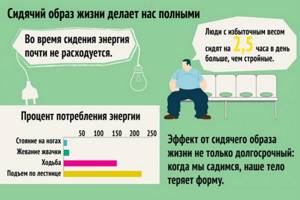Consequences
Leading a sedentary lifestyle leads to:
- Metabolic disorders.
- Deterioration of blood supply to organs.
- Diseases of the heart and blood vessels (hypertension, ischemia, varicose veins).
- Endocrine disruptions.
- Unsatisfactory indicators of tolerance to mental and physical stress, decreased performance.
- Overweight, obesity.
- Poor posture, dysfunction of the spine, joints, and the entire musculoskeletal system.
- Weakening, muscle atrophy.
- Respiratory disorders.
- Gastrointestinal pathologies.
- Hormonal imbalance.
- Diseases affecting the reproductive system.
- Problems with sleep.
- Painful sensations in various parts of the body.
- Psycho-emotional disorders.
- Oncology.
Studying the dynamics of the development of pathological processes allows us to conclude that a sedentary lifestyle negatively affects the well-being and functioning of almost all systems.
Diseases associated with a sedentary lifestyle
If we talk about diseases associated with a sedentary lifestyle, then first of all we should mention obesity and diabetes. This is also associated with the risk of developing various forms of cancer. In the United States, the consequences of a sedentary lifestyle are defined as the disease of physical inactivity. In addition to cardiovascular diseases and diabetes, this list also includes depression, dementia, breast and colon cancer, because the likelihood of their occurrence increases if a person spends a significant part of his life in a sedentary position. In the future, researchers will likely figure out why sitting is so dangerous. In essence, more important than understanding the reason for what is happening is the awareness that such a relationship exists.
Many people do work that requires sitting at a desk for long periods of time, and also spend time in front of the TV and at the computer, but at home, they go to the gym three times a week and believe that in this way they compensate for the lack of movement.
This state of affairs needs to be rethought. In addition, it should be added that intense half-hour walks are not enough. First of all, you need to avoid sitting for too long, and this can be achieved through short sessions of leg stretching, which is equivalent to physical activity. If you are an untrained person, taking a daily 30-minute walk and avoiding prolonged sitting can significantly improve your health.
Diseases from inactivity
With insufficient physical activity, a malfunction occurs in the functioning of the entire body, as well as its individual organs. All calories that were consumed with food throughout the day must be absorbed and toxins removed.
When a person does not move enough, this rule does not apply, since there is no need to expend energy. In this case, the metabolism is disrupted. Excessive amounts of harmful substances accumulated by the body are not removed from it, which causes a clear deterioration in well-being.
Bad feeling
Most of those who have had to deal with insufficient physical activity, sooner or later may feel:
- significant decrease in spinal flexibility;
- apathy, depression;
- hands and feet begin to go numb and cold;
- difficulty falling asleep in the evening and waking up in the morning;
- soreness;
- lethargy, constant fatigue.
Diseases
The consequences could be even more dire. As a result of the conditions mentioned above, diseases such as:
- Osteochondrosis and scoliosis. These diseases develop due to insufficient load on the spine. Since the joints do not move, salt deposits occur in them, which can block normal blood circulation.
- Obesity. Eating should not be followed by physical activity. Consequently, a sedentary lifestyle causes the accumulation of unused resources in the body, which accumulate in the form of fat deposits.
- Constipation. A sitting position is unnatural for our body. A long stay in this state negatively affects the intestines, peristalsis is disrupted and constipation occurs. If this happens, then in addition to physical activity, you also need to undergo an appropriate examination by a specialized doctor to restore your normal state.
- Constant headache. Significant overstrain of the cervical spine is its main cause.
- Phlebeurysm. Many people have noticed how their lower extremities hurt after a working day spent in a sedentary position. This happens due to stagnation of venous blood. Over time, the tone of the vein walls weakens.
- Problems with the reproductive system. For both men and women, sitting for long periods of time has a negative impact on the reproductive system. The reason is stagnation of blood in the pelvic area. According to statistics, it is for this reason that the number of infertility diagnoses has increased significantly.
But what to do if you can’t give up this lifestyle completely? How to minimize the harm of working at a computer or activities that require sitting? Everything is very simple! We must minimize its negative consequences. And the best way out of this situation will be regular physical exercise.
Physical activity is the key to health
Avoiding the negative effects that a sedentary lifestyle has on our body is very simple. The main thing is to overcome laziness and start moving more: exercise your body in sports or gymnastics, walk a lot, and give up the elevator. This will have a positive impact on the health of every person: children, youth, mature and elderly people. Only then will the number of pathologies be reduced and the nation will be healthy.
Have you heard the word “physical inactivity”? It may not be familiar to everyone. Most people unfamiliar with this term believe that it is such a disease. Although from a medical point of view this is not entirely true, I would like to call this phenomenon a disease. We are talking about a lack of physical activity, the epidemic of which has simply overwhelmed our society.
Who is guilty?
If you want, of course, you can always find the culprit, but let’s try to consider only objective reasons:
- A huge number of automatic and robotic technologies. They make our life simpler and easier, save energy and time: elevators, remote control, home assistant machines, cars and other mechanisms that do everything for us;
- The need to earn more and increase working hours. Of course, this point applies to people in non-physical types of labor. Working in an office or at the reception desk, for example, confines you to a chair for the whole day, giving you rare runs to and from your boss or colleague’s office. By the end of the day, only one muscle group gets tired - the back;
- The spread of a culture of passive entertainment, which has one common scenario - a person sits and rejoices.
Each of you can add something else to this list. But understanding the reason is only half the battle. You should be very careful about the consequences of lack of sufficient mobility.
Why is it dangerous?

The very first and most terrible thing is the aging of the respiratory and cardiovascular systems. The fact is that when performing its daily tasks, our body uses only a third of its potential, while to maintain tone, we need to load ourselves by no less than 60%, and to develop systems - by 80%. Only athletes work at full capacity when they are going for a record.
Another unpleasant consequence is obesity. While a person sits, fat grows, everything is even. Moreover, it grows not only on the sides and hips, but also around the internal organs, filling the abdominal cavity and putting pressure on the diaphragm. This is why fat people always have difficulty breathing. This leads to decreased oxygen levels in the blood and poor health. In addition, additional weight also puts a strain on all body systems, especially the heart.
Then it simply follows a chain reaction: weakening of the skeleton, joint diseases, lethargy, weakness, apathy. The muscles atrophy and lose weight and volume, and problems with posture develop. This complex then leads to many serious diseases. At the same time, the psychological comfort of an immobile person also drops rapidly. But is there a way to somehow combat this phenomenon?
What to do?
Of course, physical inactivity is not a death sentence, because it really is not even a disease! So you can confidently go into battle with her tomorrow. To achieve a guaranteed victory, we recommend:
- Skip the elevator - just forget about it, especially within five floors. Daily ascent and descent of stairs will already give your legs and back a little workout;
- Try to drive less. You can walk or use public transport. This way you will not only be able to save nature, but also add another kilometer or two to your walk;
- Go for a walk in the park during your lunch break. At least just walk along a non-busy street. This will help both raise your activity level and clear your head from work;
- Get a dog. This is, of course, a joke, but the need to walk a pet drives its owners to the park for a quick walk at least twice a day.
Even these small tips will be enough to stay young and healthy for a long time, and if you add proper nutrition and regular exercise, then your age will remain a mystery and an amazing fact for everyone around you.
Inactivity and its impact on the psychosomatic state of the body
A sedentary lifestyle is extremely dangerous for mental health. Comprehensive studies are currently being conducted in this area, confirming negative forecasts.

A person who does not pay enough attention to physical activity is more likely to:
- increased anxiety,
- depression,
- stress,
- sleep disorders,
- memory impairments,
- decreased appetite,
- various clinical mental illnesses.
This tendency is due to the fact that physical inactivity causes pathological changes in the body and destroys health, including at the hormonal level.
Please note: As a result of physical exercise of any kind, endorphins are released in the body, which are responsible for a person’s psychological well-being and the achievement of relaxation.
Regular activity is the best way to stabilize the mental state of the body, return it to normal shape, improve health, improve overall well-being and eliminate pathological manifestations.
Physical inactivity and excess weight
Movement is life itself, and voluntary restriction of physical activity leads to a significant loss of strength, negatively affects health, and undermines a person’s psychological well-being. A passive lifestyle naturally leads to the accumulation of extra pounds and further obesity. First of all, the health of the body suffers. A sedentary lifestyle directly provokes a slowdown in metabolism and blood circulation. As a result, excess calories accumulate, which are transformed into fat deposits. For many people, particularly young girls, this becomes a real problem.
The immediate consequences of excess weight accumulation are the following pathological conditions:
- cardiovascular diseases,
- hypertension,
- increased cholesterol levels,
- diabetes,
- gallbladder diseases,
- arthritis,
- oncological lesions.
In addition, the impact of physical inactivity on health is not limited to these consequences.

If a person is very concerned about the problem of excess weight and the resulting complex of external unattractiveness, states of mental depression, anxiety, and even depression may arise.
Important: It is worth noting that the consequences of a sedentary lifestyle for the body can be quite short-term, or longer, and even chronic.
The problem of excess weight is always associated with a number of other more or less serious pathologies, and can provoke serious disorders. Therefore, it is very important to monitor the condition of your body and prevent pathological changes.
Marathon running while standing
You can always find an opportunity to stand up for at least a minute. If you work at a computer, standing for at least an hour during the workday can burn 60 calories, further reducing the health risks associated with a sedentary lifestyle. Don't you think this result is too impressive? Over the course of a five-day working week, this amount increases to 300 kcal, over the course of a year to 10 thousand kcal, and this is the same amount as consumed during three marathon races.
Table: Book “Swedish Health Rules”











